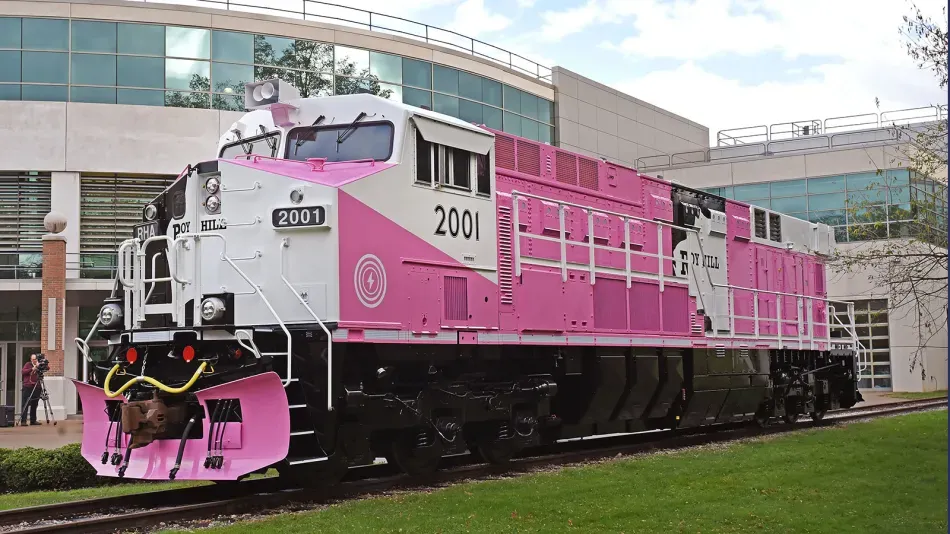Regulator orders Stokes' Seven Group to fix leaking gas well off Victorian coast
SGH's decade of neglect of its Longtom gas field off the Gippsland coast is "an erosion of good industry practice" according to NOPSEMA.
Battery-electric locomotive deliveries to all the big Pilbara iron ore miners are running late as heavy long-distance loads prove a technical challenge.

WA's big four iron ore miners who committed to battery-powered trains more than three years ago are all waiting on late deliveries of the emissions-savings technology.
Climate sceptic Gina Rinehart's Roy Hill, renewable energy evangelist Andrew Forrest's Fortescue, and mining giants BHP and Rio Tinto all want to reduce their consumption of expensive diesel and production of greenhouse gases from moving more than 800 million tonnes of iron ore to port every year.
It is understood one technical challenge has been to increase the batteries' "energy density" so they can deal with the long distances and massive loads of Pilbara iron oremining .
BHP uses four locomotives to pull 270 ore cars carrying 38,000 tonnes of iron ore.
In the Pilbara alone, BHP has 180 locomotives, and Fortescue uses 70.
There is a vast market for whatever company cracks the technology.
WA's miners are waiting on deliveries from Caterpillar-owned Progress Rail in Brazil and US firm Wabtec.
The miner under most pressure is Fortescue, which aims to eliminate its greenhouse gas emissions by 2030—just 5½ years away. Its trains burn 82 million litres of diesel a year.
Unlike its competitors the Andrew Forrest-chaired company is developing its own battery-electric locomotive technology as well as wanting to trial equipment from established manufacturers.
Three years ago, Fortescue announced it would develop an "Infinity Train" that would not require charging.
Energy stored on the mainly downhill, fully loaded run from mines to port would be sufficient to drive the empty train back to the mine 600m above sea level.
However, a charge-free train may have proven difficult to achieve.
Fortescue is now collaborating with Australian firm Downer.
A Downer video said the technology would be "backed up with overhead line dynamic charging for operational flexibility, " indicating that energy stored from regenerative braking may be insufficient to power a return trip in the Pilbara.
A Fortescue spokeswoman said the miner's commitment to "Real Zero by 2030" was steadfast.
"We see electrification as being well-suited for the high-capacity, heavy-haul nature of our rail operations, and we are actively engaging with multiple potential technology providers," she said.
Fortescue's spokeswoman said its collaboration with Downer was just one example of its progress towards decarbonising rail operations with a prototype currently under construction.
purchased - September 2001 - one Wabtec 7 megawatt-hour FLXdrive battery-electric locomotive for delivery in 2023.
plan - Replace one of four diesel locomotives used to pull a 2.7 km-long train carrying 33,000 tonnes of iron ore.
The locomotive would recharge during the trip from regenerative braking to achieve a "double-digit" percentage reduction in fuel costs and emissions for the entire train.
Includes unique liquid cooling to control battery temperature in the Pilbara heat.
status - In October 2023, Wabtec announced it was to be shipped to Australia in 2024. No further news has been released.

Progress Rail
purchased - January 2022 - 2 x Progress Rail eight-axle 14.5 megawatt-hours BE14.5 battery-electric locomotives for first delivery in 2023.
plan - Zero emissions by 2030
status - Locomotives are currently under construction and are due to be delivered for mainline rail testing in 2025, according to a Fortescue spokeswoman.
In-house design
started developing - March 2022 - A world-first "Infinity Train" that would not need recharging, to possibly be deployed by 2024.
plan - To be developed by Williams Advanced Engineering, which was bought by Fortescue in January 2022 and is now called Fortescue Zero.
status - Fortescue Zero and Australia's Downer agreed in September 2024 to jointly develop a battery-electric locomotive. "Trials are underway."
ammonia-powered train
started developing - October 2022 - with German rail company Deutsche Bahn modifications to existing diesel engines, allowing them to run on hydrogen or ammonia.
plan - key technology was a German-developed "cracker" to be installed on the train to separate hydrogen from a small amount of ammonia to be used to help ignite the ammonia.
status - trials of a dual-fuelled prototype ammonia-powered locomotive were completed at Fortescues's Solomon operation in the Pilbara.
purchased - January 2022 - four Wabtec 7 megawatt-hour FLXdrive battery-electric locomotives with initial trials in the Pilbara planned in early 2024.
plan - Contribute to Rio's goal of reducing carbon emissions by 50 per cent by 2030. Locomotives emit 30 per cent of Rio's diesel-related emissions in the Pilbara.
status - Rio Tint0 and Wabtec are continuing to work together
purchased - January 2022 - purchased four battery-electric locomotives four delivery in late 2023:
- two Progress Rail 8-axle, 14.5-MWh battery capacity
- two Wabtec FLXdrive locomotives
plan - trial technology to "be better informed as we prepare for the planned replacement of our diesel-powered iron ore rail fleet."
status - In 2024, Tim Day, who leads BHP's WA iron ore operation, said the company will test Wabtec and Progress Rail battery electric locomotives "from 2025.”
All the info and a bit of comment on WA energy, industry and climate every Friday